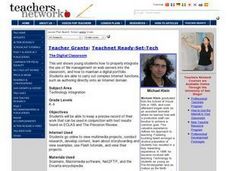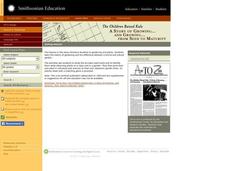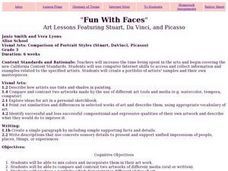Curated OER
Mini Coil Pots: Ceramics Lesson
Art is a wonderful way to teach historical or cultural concepts. Here, learners view a series of coil pots that have been created throughout history by a variety of civilizations. They then create and decorate a pot of their own that...
Curated OER
Basic Paragraph
Explore basic paragraphs. Young writers compose a topic sentence, supporting sentences, and a concluding sentence. This lesson is intended for use with a SMART Board, a software technology web link is induced.
Curated OER
The Three Gorges: Should Nature or Technology Reign?
Young scholars examine the construction of the Three Gorges Dam in China. In this Three Gorges Dam activity, students research Internet sources pertaining to the dam. Young scholars discuss the geography and culture of East China as...
Curated OER
Indegenous Cultures Magazine in Publisher
Fourth graders use Publisher to create their own magazine. In this online magazine lesson, 4th graders follow the instructions to create a magazine using text, pictures, and colors within the Publisher system.
Curated OER
Separate But Equal Video
Eighth graders watch the video "Separate But Equal." They choose an incident or event from the video that is interesting or meaningful to them and write an objective news article and an editorial.
Curated OER
Communication Overload
Pupils take a trip through time to find out how language, and other ways of communicating, have evolved. They see how the specific technologies of e-mail and spam work and discover the most modern methods of blocking unwanted messages.
Curated OER
The Story of Harvey
Students explore the concept of responsibility. In this character education lesson, students read The Story of Harvey. Student discuss the levels of responsibility of each character in the story.
Curated OER
Technology: The Digital Classroom
Students discover how to integrate file management systems on Web servers into the classroom. In addition to maintaining digital portfolios, they develop various Internet functions such as authoring directly onto an Internet domain.
Curated OER
Baga Drum
Students examine a Baga Drum in order to explore the history of the Baga people of West Africa. In this art history lesson, students recognize figures used in Baga Drum design that represent aspects of Baga culture. They also design and...
Curated OER
Fun With Faces: Stuart, Da Vinci and Picasso
Third graders conduct research and review art work to compare the styles of Stuart, Da Vinci and Picasso. They develop and compile a portfolio including masterpieces of these artists and original works. Students compose detailed...
Curated OER
Restoring the Nike
Students explore the roles of artists, art historians and archaeologists. They discover the role of professionals in restoring lost or damaged artwork. Students examine the characteristics of Greek art.
Curated OER
Runaways Past and Present
Tenth graders use video and the Internet to compare runaway teenagers of the 1930s with runaways today. The lesson uses the integration of technology in order to build skills and conduct research.
Curated OER
Using the Commentaries in Class
Students examine language and communication by listening to a commentary radio show. In this communications lesson plan, students listen to Michael Josephson's radio broadcast using the Internet and analyze his words and their meaning....
Curated OER
Regions of the United States
Students present a travelogue, an alternate format to preparing their writing, of a specific U.S. geographic region that includes the aspects of population, climate, landforms, economics, culture, famous people and places and natural...
Curated OER
Pen Pals
Students write to a pen pal and learn about their lives. In this pen pal lesson, students learn about a person from another country. Students develop an understanding that they have many things in common with people from other parts of...
Curated OER
Dishonesty: Clues and Consequences
Learners explore trustworthiness and dishonesty. In this character development lesson, students discuss dishonest behavior. Learners develop scenarios about dishonesty and decide what consequences the person should have.
Curated OER
What's the News? Articles of Deception
Students choose a event in the news involving deception. In this deception lesson, students develop questions and share them. Students answer critical thinking questions about their event and describe what they learned about honesty. ...
Curated OER
Who Needs My Help?
Students think about helping others. In this citizenship instructional activity, students think of people in their lives who could use their help. Students illustrate the things they do to help others.
Curated OER
Responsible Youth in the News
Students research newspapers and magazines for articles about young people being responsible or being irresponsible. In this responsibility lesson, students discuss responsibility and the articles. Students answer questions in groups...
Curated OER
Character Book
Young scholars discover the behavior that represents trustworthiness, respect, responsibility, fairness and caring. For this character lesson, students make a collage of pictures demonstrating good behavior.
Curated OER
Five Artists of the Mexican Revolution
Young scholars discover details about Mexican Revolution era artists. In this Mexican Revolution lesson, students research the events and people of the time period. Young scholars then research the artists of the time and create their...
Curated OER
My Side of the Mountain
Learners complete activities with the book My Side of the Mountain by Jean Craighead George. In this literature lesson, students read the book and discuss the concept of human capital. They complete a KWLH chart and two assessments.
Curated OER
From Airmail to Airlines
Students explore changes in air transportation from 1920 to the present. For this air flight lesson plan, students are introduced to the history of air transportation. This lesson plan contains three different activities that will...
Curated OER
More of, Less of
Have your class discuss behaviors they like from other people. They will then get into groups and list behaviors they want to see more of from people in their community, classroom, or school. This is a great Character Counts lesson!

























